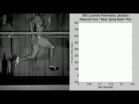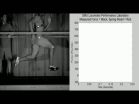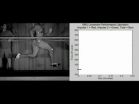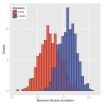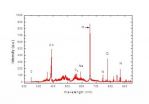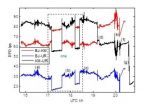(Press-News.org) VIDEO:
The contemporary view of running mechanics has been heavily influenced by the simple spring-mass model, a theory first formulated in the late 1980s. The spring-mass model assumes the legs work...
Click here for more information.
The world's fastest sprinters have unique gait features that account for their ability to achieve fast speeds, according to two new studies from Southern Methodist University, Dallas.
The new findings indicate that the secret to elite sprinting speeds lies in the distinct limb dynamics sprinters use to elevate ground forces upon foot-ground impact.
"Our new studies show that these elite sprinters don't use their legs to just bounce off the ground as most other runners do," said human biomechanics expert and lead author on the studies Ken Clark, a researcher in the SMU Locomotor Performance Laboratory. "The top sprinters have developed a wind-up and delivery mechanism to augment impact forces. Other runners do not do so."
The new findings address a major performance question that has remained unanswered for more than a decade.
Previous studies had established that faster runners attain faster speeds by hitting the ground more forcefully than other runners do in relation to their body weight. However, how faster runners are able to do this was fully unknown. That sparked considerable debate and uncertainty about the best strategies for athletes to enhance ground-force application and speed.
"Elite speed athletes have a running pattern that is distinct," Clark said. "Our data indicate the fastest sprinters each have identified the same solution for maximizing speed, which strongly implies that when you put the physics and the biology together, there's only one way to sprint really fast."
The critical and distinctive gait features identified by the study's authors occur as the lower limb approaches and impacts the ground, said study co-author and running mechanics expert Peter Weyand, director of the SMU Locomotor Performance Lab.
"We found that the fastest athletes all do the same thing to apply the greater forces needed to attain faster speeds," Weyand said. "They cock the knee high before driving the foot into the ground, while maintaining a stiff ankle. These actions elevate ground forces by stopping the lower leg abruptly upon impact."
The new research indicates that the fastest runners decelerate their foot and ankle in just over two-hundredths of a second after initial contact with the ground.
The researchers reported their findings with co-author and physicist Laurence J. Ryan, research engineer for the SMU Locomotor Performance Laboratory in the Annette Caldwell Simmons School of Education & Human Development.
The finding that elite sprinters apply greater ground forces with a distinctive impact pattern is reported in the Journal of Applied Physiology in the article, "Are running speeds maximized with simple-spring stance mechanics?" It appears online at http://bit.ly/1Be92Mk in advance of appearing in the print journal.
The finding that faster athletes deliver a firm, rapid punch to the ground upon contact is reported in The Journal of Experimental Biology, in the article "Foot speed, foot-strike and footwear: linking gait mechanics and running ground reaction forces." It appears online at http://bit.ly/1uskM9v.
Studies compared data from competitive sprinters to other athletes
The tests conducted at SMU's Locomotor Performance Lab compared competitive sprinters to other fast-running athletes.
The competitive sprinting group included track athletes who specialized in the 100- and 200-meter events. More than half had international experience and had participated in the Olympics and Track and Field World Championships.
VIDEO:
The two-mass model theorizes that running vertical force-time waveforms consist of two components, each corresponding to the motion of a portion of the body's mass. A smaller component corresponds to...
Click here for more information.
They were compared to a group of athletes that included competitive soccer, lacrosse and football players.
All the athletes in both groups had mid- and fore-foot strike patterns. Their running mechanics were tested on a custom, high-speed force treadmill that allowed the researchers to capture and analyze hundreds of footfalls at precisely controlled speeds.
Video captured for the studies is posted to the SMU Locomotor Performance Lab Youtube channel, http://bit.ly/1tBpGRN. Images on flickr are at http://bit.ly/YKwAtB.
The researchers measured ground-force patterns over a full range of running speeds for each athlete from a jog to top sprinting speed.
"We looked at running speeds ranging from 3 to 11 meters per second," Clark said. "Earlier studies in the field of biomechanics have examined ground reaction force patterns, but focused primarily on jogging speeds between 3 and 5 meters per second. The differences we found became identifiable largely because of the broad range of speeds we examined and the caliber of the sprinters who participated in the study."
Classic spring model of running does not explain the unique gait features of top sprinters
The contemporary view of running mechanics has been heavily influenced by the simple spring-mass model, a theory first formulated in the late 1980s. The spring-mass model assumes the legs work essentially like the compression spring of a pogo stick when in contact with the ground.
In this theory, during running at a constant speed on level ground, the body falls down out of the air. Upon landing, the support leg acts like a pogo stick to catch the body and pop it back up in the air for the next step.
It's been generally assumed that this classic spring model applies to faster running speeds and faster athletes as well as to slower ones.
Elite sprinters do not conform to widely accepted theories of running mechanics
Clark, Ryan and Weyand questioned whether such a passive catch-and-rebound explanation could account for the greater ground forces widely understood as the reason why sprinters achieve faster speeds.
After the researchers gathered ground reaction force waveform data, they found that sprinters differed from other athletes. From there they compared the waveforms to those predicted by the simple spring in the classic model.
"The elite sprinters did not conform to the spring-model predictions," said Clark. "They deviated a lot, specifically during the first half of the ground-contact phase. Our athlete non-sprinters, on the other hand, conformed fairly closely to the spring-model predictions, even at their top speeds."
Weyand said the new findings indicate that the classic spring model is not sufficient for understanding the mechanical basis of sprint running performance.
"We found all the fastest athletes applied greater ground forces with a common and apparently characteristic pattern that resulted from the same basic gait features," he said. "What these sprinters do differently is in their wind up and delivery mechanics. The motion of their limbs in the air is distinct; so even though the duration of their limb-swing phase at top speed does not differ from other runners, the force delivery mechanism differs markedly."
Sprinters have a common mechanical solution for speed — one that athletes who aren't as fast do not execute.
"This provides scientific information so coaches and athletes can fully identify what to train," Clark said. "It is our hope that our results can translate into advances in evidence-based approaches to training speed."
INFORMATION:
The research was funded by the U.S. Army Medical Research and Materiel Command and SMU's Simmons School of Education and Human Development.
SMUResearch.com on Twitter, http://twitter.com/smuresearch.
For more information, http://www.smuresearch.com.
SMU is a nationally ranked private university in Dallas founded 100 years ago. Today, SMU enrolls nearly 11,000 students who benefit from the academic opportunities and international reach of seven degree-granting schools. For more information see http://www.smu.edu.
SMU has an uplink facility located on campus for live TV, radio, or online interviews. To speak with an SMU expert or book an SMU guest in the studio, call SMU News & Communications at 214-768-7650.
Key to speed? Elite sprinters are unlike other athletes -- deliver forceful punch to ground
New research finds that world-class sprinters attack the ground to maximize impact forces and speed
2014-08-26
ELSE PRESS RELEASES FROM THIS DATE:
Crohn's disease gene discovery points towards new treatments
2014-08-26
Genetic changes that occur in patients with the bowel condition Crohn's disease could hold clues to fighting the illness.
Scientists have identified chemical changes in the DNA of patients with Crohn's disease that could help to screen people for the disease.
These changes can be detected in blood samples, opening the door to a simple test for Crohn's disease.
The findings also offer clues to how the condition develops and reveal possible targets for new treatments.
Several genes have been linked to Crohn's disease but not everybody who inherits these genes will ...
Bombarded by explosive waves of information, scientists review new ways to process and analyze Big Data
2014-08-26
Big Data presents scientists with unfolding opportunities, including, for instance, the possibility of discovering heterogeneous characteristics in the population leading to the development of personalized treatments and highly individualized services. But ever-expanding data sets introduce new challenges in terms of statistical analysis, bias sampling, computational costs, noise accumulation, spurious correlations, and measurement errors.
The era of Big Data – marked by a Big Bang-like explosion of information about everything from patterns of use of the World Wide ...
Chinese scientists use laser-induced breakdown spectroscopy to identify toxic cooking 'gutter oil'
2014-08-26
The illegal use of waste cooking oil in parts of the nationwide food system is threatening the public's health in China.
Now scientists led by Professor Ding Hongbin at the Dalian University of Technology, in northeastern China, present a new means to confront this problem. In a study published in the Chinese Science Bulletin, Ding and fellow researchers at the university's School of Physics and Optoelectronic Engineering outline the potential use of laser-induced breakdown spectroscopy (LIBS) to rapidly distinguish between "gutter oil" and safe, edible oil.
...
Same-beam VLBI Technology successfully monitors the Chang'E-3 rover's movement on the lunar surface
2014-08-26
By using the same-beam VLBI technology, differential phase delay successfully monitored the lunar rover's movement during the Chang'E-3 mission when rover and lander was carrying out the tasks of separation and took photos of each other. The sensitivity of rover motion monitoring was between 50-100mm.Furthermore, relative position between rover and lander was precisely measured by taking the use of the DPD's changing trend. Professor LIU Qing hui and his student ZHENG Xin from the Shanghai Astronomical of observatory, Chinese Academy of Sciences, obtained this result when ...
Laser pulse turns glass into a metal
2014-08-26
Quartz glass does not conduct electric current, it is a typical example of an insulator. With ultra-short laser pulses, however, the electronic properties of glass can be fundamentally changed within femtoseconds (1 fs = 10^-15 seconds). If the laser pulse is strong enough, the electrons in the material can move freely. For a brief moment, the quartz glass behaves like metal. It becomes opaque and conducts electricity. This change of material properties happens so quickly that it can be used for ultra-fast light based electronics. Scientists at the Vienna University of ...
Study calls into question link between prenatal antidepressant exposure and autism risk
2014-08-26
Previous studies that have suggested an increased risk of autism among children of women who took antidepressants during pregnancy may actually reflect the known increased risk associated with severe maternal depression. In a study receiving advance online publication in Molecular Psychiatry, investigators from Massachusetts General Hospital (MGH) report that – while a diagnosis of autism spectrum disorder was more common in the children of mothers prescribed antidepressants during pregnancy than in those with no prenatal exposure – when the severity of the mother's depression ...
Study: Earth can sustain more terrestrial plant growth than previously thought
2014-08-26
CHAMPAIGN, Ill. — A new analysis suggests the planet can produce much more land-plant biomass – the total material in leaves, stems, roots, fruits, grains and other terrestrial plant parts – than previously thought.
The study, reported in Environmental Science and Technology, recalculates the theoretical limit of terrestrial plant productivity, and finds that it is much higher than many current estimates allow.
"When you try to estimate something over the whole planet, you have to make some simplifying assumptions," said University of Illinois plant biology professor ...
New tool to probe cancer's molecular make-up
2014-08-26
Scientists have shown how to better identify and measure vital molecules that control cell behaviour – paving the way for improved tools for diagnosis, prediction and monitoring of cancer.
Researchers from the Cancer Research UK Manchester Institute based at The University of Manchester – part of the Manchester Cancer Research Centre – and the Institute of Cancer Research, London, looked at protein kinases, molecules that control various aspects of cellular function.
The study, funded by a Biotechnology and Biological Sciences Research Council (BBSRC)/Pfizer CASE studentship ...
Symptoms after breast cancer surgery need to be treated on an individual basis
2014-08-26
For those affected, breast cancer is a dramatic diagnosis. Patients often have to endure chemotherapy and surgery, which, depending on the individual scenario, may mean breast conserving surgery or breast removal—mastectomy. In the aftermath, many women experience symptoms such as pain, fatigue/exhaustion, or sleep disturbances. However, the symptoms are highly individual, as Stefan Feiten and colleagues emphasize in a recent study reported in Deutsches Ärzteblatt International (Dtsch Arztebl Int 2014; 111: 537-44).
The authors state that it is crucial for good aftercare ...
Life in Saxony-Anhalt: More attention should be paid to the heart!
2014-08-26
A lack of education, an unhealthy diet, and unemployment go straight to the heart—quite literally, because all three range among the risks that cause ischemic heart disease or contribute to its development. According to a recent study reported by epidemiologists Andreas und Maximilian Stang in Deutsches Ärzteblatt International (Dtsch Arztebl Int 2014; 111: 530-6), the risk factors for heart disease are higher in Saxony-Anhalt than in all other German states, and more persons die from heart disease in the state.
Many of the risk factors could be treated in a more targeted ...
LAST 30 PRESS RELEASES:
Menopausal hormone therapy may not pose breast cancer risk for women with BRCA mutations
Mobile health tool may improve quality of life for adolescent and young adult breast cancer survivors
Acupuncture may help improve perceived breast cancer-related cognitive difficulties over usual care
Nerve block may reduce opioid use in infants undergoing cleft palate surgery
CRISPR primes goldenberry for fruit bowl fame
Mass General Brigham announces new AI company to accelerate clinical trial screening and patient recruitment
Fat tissue around the heart may contribute to greater heart injury after a heart attack
Jeonbuk National University researcher proposes a proposing a two-stage decision-making framework of lithium governance in Latin America
Chromatin accessibility maps reveal how stem cells drive myelodysplastic progression
Cartilaginous cells regulate growth and blood vessel formation in bones
Plant hormone allows lifelong control of proteins in living animal for first time
Swedish freshwater bacteria give new insights into bacterial evolution
Global measures consistently underestimate food insecurity; one in five who suffer from hunger may go uncounted
Hidden patterns of isolation and segregation found in all American cities
FDA drug trials exclude a widening slice of Americans
Sea reptile’s tooth shows that mosasaurs could live in freshwater
Pure bred: New stem cell medium only has canine components
Largest study of its kind highlights benefits – and risks – of plant-based diets in children
Synergistic effects of single-crystal HfB2 nanorods: Simultaneous enhancement of mechanical properties and ablation resistance
Mysterious X-ray variability of the strongly magnetized neutron star NGC 7793 P13
The key to increasing patients’ advance care medical planning may be automatic patient outreach
Palaeontology: Ancient tooth suggests ocean predator could hunt in rivers
Polar bears may be adapting to survive warmer climates, says study
Canadian wildfire smoke worsened pediatric asthma in US Northeast: UVM study
New UBCO research challenges traditional teen suicide prevention models
Diversity language in US medical research agency grants declined 25% since 2024
Concern over growing use of AI chatbots to stave off loneliness
Biomedical authors often call a reference “recent” — even when it is decades old, analysis shows
The Lancet: New single dose oral treatment for gonorrhoea effectively combats drug-resistant infections, trial finds
Proton therapy shows survival benefit in Phase III trial for patients with head and neck cancers
[Press-News.org] Key to speed? Elite sprinters are unlike other athletes -- deliver forceful punch to groundNew research finds that world-class sprinters attack the ground to maximize impact forces and speed
